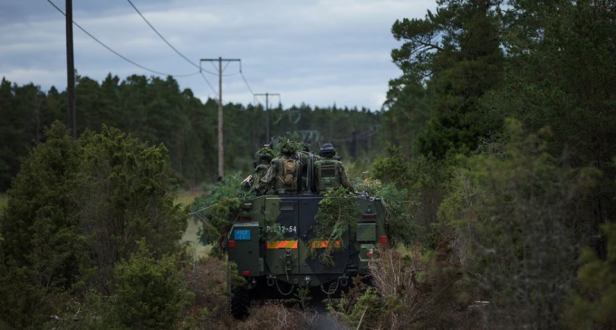Upon thy glimmering thresholds, when the steam
Floats up from those dim fields about the homes
Of happy men that have the power to dieTithonus cries out to Aurora, the goddess of dawn
Alfred, Lord Tennyson – “Tithonus”
Perhaps the final sign to show that Sweden has now moved out of the notorious ‘strategic blackout’ is the major exercise Aurora 17 currently underway in the southern parts of the country. In absolute numbers this is the largest Swedish exercise in over twenty years, while in relative numbers this is the largest share of the country’s defence forces ever to simultaneously take part in a single exercise.

No points to the one who figures out which country would play the part of Country A or which three would be Country B in a potential real-world scenario.
The exercise is vastly more complex than the above would suggest. The first part of the exercise is the transportation of the forces of Country A (the main OPFOR of the exercise) to Gotland. A significant part of these are foreign detachments, including heavy US forces and a Finnish mechanised rapid deployment company from the Pori Brigade. The Swedish Home Guard (Hemvärnet) protects key transports, not as an exercise, but providing security to their foreign guests by patrolling with loaded weapons. This is the host nation support agreement in reality, providing for the needs of foreign reinforcements arriving to help (in this case Sweden) in the defence of one’s country.
The decision regarding which forces get to play OPFOR is revealing, as it is highly likely that they represent the kind of forces the Swedish headquarters expect could be offered as assistance in case of an escalated crises in the Baltic region. These include both the Finnish mechanised company, a US Marine Corps company, US airborne/airmobile forces, and the premier Swedish light units in the form of their Army Ranger battalion (Arméns jägarbataljon) and the 31. Airmobile battalion (31. Luftburna).
The interesting thing here is obviously that this works both ways: the “invaders” get to practice how to rapidly get to Gotland, while the local Swedish forces present there get to practice defending against light mechanised and airmobile forces.
As has been discussed earlier on the blog, the defence of Gotland is crucial for Finland as well as for the Baltic states. MoD Jussi Niinistö makes no secret that what the Finnish Defence Forces practice in the exercise is how to provide support to Sweden, while also noting that the lessons are readily transferable to a scenario where Sweden would support us instead. This is in line with his speech last week, where he noted that Finnish-Swedish defence cooperation aims at being able to, amongst other things, jointly defend “some place”. Feel free to speculate which region(s) that “some” might be.

What is clear is that in the shadow of everything else taking place during Aurora 17 Finland is not simply practicing joint international operations with Swedish (and US) forces. Instead, we are openly practicing defending Swedish territory against an enemy invader, and how to do this together with Swedish forces. We are also doing this with the very units that would be involved. If things suddenly would turn bad, the Finnish officers at the head of the units sent to aid our western ally would be familiar with the peculiarities of the terrain of Gotland, and would be able to recognise both the local forces and the light Swedish forces likely to make up the first wave of reinforcements, knowing their strengths and weaknesses and how to best cooperate with them.
While no promises have yet been made, politicians on both sides are currently making sure that they will at least have all options available to them if the gathering clouds would turn into a tempest.



Thanks for an excellent summary of the exercise. Both depth and detail.
Dr. Tomas Ries
Senior Lecturer / Associate Professor
National Defence College Sweden
Thank you very much, glad to hear you liked it!
//Robin
Will there be any return of the favour later?
https://www.hbl.fi/artikel/tuomioja-motsatter-sig-krigsovning-i-finland-skravlande-kraftuppvisning-det-sista-vi-behover/
Reblogged this on vara bungas and commented:
Proud to mention that Latvian HG platoon takes part in A-17
Brilliant, thank you!!